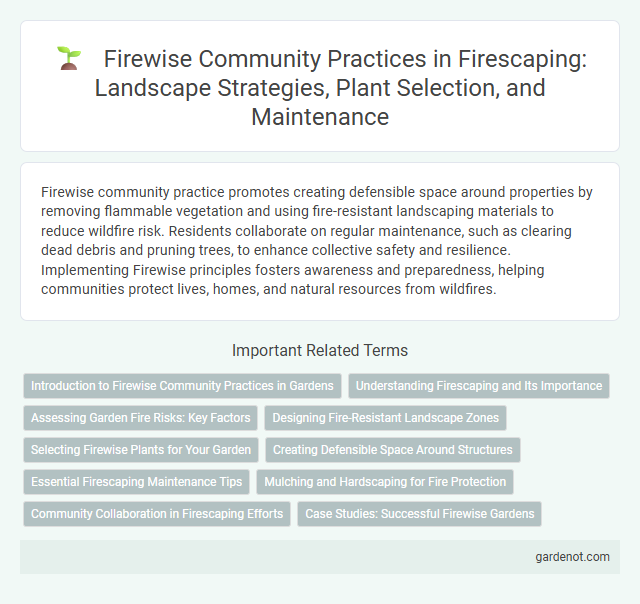Firewise community practice promotes creating defensible space around properties by removing flammable vegetation and using fire-resistant landscaping materials to reduce wildfire risk. Residents collaborate on regular maintenance, such as clearing dead debris and pruning trees, to enhance collective safety and resilience. Implementing Firewise principles fosters awareness and preparedness, helping communities protect lives, homes, and natural resources from wildfires.
Introduction to Firewise Community Practices in Gardens
Firewise community practices in gardens emphasize strategic landscaping to reduce wildfire risks by selecting fire-resistant plants and maintaining proper spacing between vegetation. Incorporating low-flammability materials and creating defensible spaces around homes significantly enhances community safety. Regular garden maintenance, including debris removal and pruning, minimizes fuel load and helps prevent fire spread.
Understanding Firescaping and Its Importance
Firescaping involves designing and maintaining landscapes that reduce wildfire risks, blending fire-resistant plants and strategic spacing to create defensible zones around properties. Firewise community practices emphasize collaboration among residents to implement Firescaping techniques, significantly enhancing community resilience against wildfires. Understanding Firescaping is vital for mitigating fire hazards, preserving ecosystems, and protecting homes in fire-prone regions.
Assessing Garden Fire Risks: Key Factors
Assessing garden fire risks in Firewise communities involves evaluating vegetation types, fuel moisture levels, and spatial arrangement to reduce wildfire potential. Key factors include identifying highly flammable plants, maintaining defensible space through proper pruning, and ensuring adequate clearance between combustible materials and structures. Implementing these practices enhances garden resilience and supports community-wide fire risk mitigation.
Designing Fire-Resistant Landscape Zones
Designing fire-resistant landscape zones in a Firewise community involves creating defensible spaces by strategically placing fire-resistant plants and non-flammable materials to slow wildfire spread. Incorporating zones with increasing clearance distances around structures reduces fuel continuity and enhances firefighter access. Effective firescaping integrates native drought-tolerant species that contain low resin and moisture content, promoting landscape resilience against extreme fire conditions.
Selecting Firewise Plants for Your Garden
Selecting Firewise plants for your garden involves choosing species with low flammability, high moisture content, and minimal resin or sap. Native plants like succulents, deciduous shrubs, and hardwood trees are ideal due to their natural resistance to fire. Incorporating Firewise plants helps create effective defensible space that reduces wildfire risk and protects your property.
Creating Defensible Space Around Structures
Creating defensible space around structures is a critical Firewise community practice that involves removing flammable vegetation and materials within a 30 to 100-foot radius of homes. This strategic clearance reduces wildfire threats by minimizing fuel sources and creating buffer zones to slow fire spread. Homeowners and communities engage in regular maintenance, including pruning trees and clearing debris, to enhance property resilience against wildfires.
Essential Firescaping Maintenance Tips
Regularly clearing dead vegetation and trimming tree branches within 30 feet of your home significantly reduces wildfire risks in Firewise communities. Maintaining a well-watered and green landscape acts as a natural fire barrier, preventing flames from easily spreading. Consistent debris removal from gutters, roofs, and yards minimizes potential fuel sources and enhances overall fire resilience.
Mulching and Hardscaping for Fire Protection
Mulching with fire-resistant materials such as gravel or lava rock significantly reduces wildfire fuel near structures by limiting combustible vegetation. Hardscaping elements like stone patios, brick walkways, and concrete driveways create effective firebreaks that slow or stop fire spread within Firewise communities. These combined practices enhance ember resistance and defensible space, critically improving home protection during wildfire events.
Community Collaboration in Firescaping Efforts
Firewise community practice strengthens wildfire resilience through active collaboration among residents, local agencies, and fire professionals to implement strategic firescaping measures. This approach emphasizes collective efforts in vegetation management, fuel reduction, and creating defensible spaces to minimize fire risks. Shared knowledge and resources enhance preparedness and response, fostering a safer, fire-adapted community environment.
Case Studies: Successful Firewise Gardens
Firewise community practice emphasizes creating defensible spaces through strategically designed Firewise gardens that use fire-resistant native plants and non-flammable materials to reduce wildfire risk. Case studies from regions like Colorado and California demonstrate that integrating drought-tolerant species, proper spacing, and mulch management significantly lowers fire intensity near homes. These successful Firewise gardens exemplify how localized vegetation management and community engagement enhance wildfire resilience in vulnerable neighborhoods.
Firewise community practice Infographic

 gardenot.com
gardenot.com